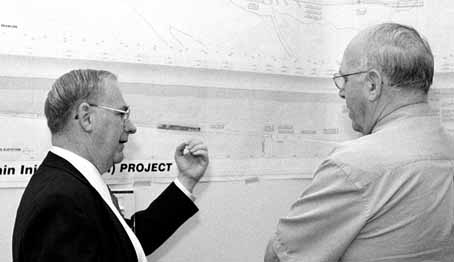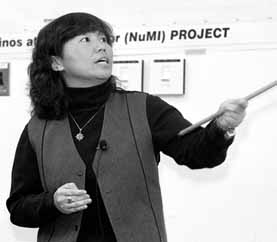 |
|
NuMI Project: Ready to Move On by Kurt Riesselmann
 Fermilab's Neutrino at the Main Injector project is still far from reaching the finish line; but in its race to become one of the top neutrino research facilities in the world, the project has overcome a big hurdle.
Fermilab's Neutrino at the Main Injector project is still far from reaching the finish line; but in its race to become one of the top neutrino research facilities in the world, the project has overcome a big hurdle.
On September 13, a Department of Energy committee chaired by Daniel Lehman concluded its three-day review of the NuMI project and recommended the adoption of a new project budget of 171.4 million dollars and a schedule that would allow for the completion of the NuMI project by 2005.
Three months ago the prospects of the NuMI project appeared far less promising. Faced with increased project costs and delayed schedules, Fermilab managers and collaborators had asked Lehman and his team of experts to "re-baseline" the project to account for a total project cost increase of 30 million dollars.
At that time, however, Lehman was "not ready to accept the changes yet." The project plans showed too many uncertainties, and the committee requested further engineering studies and changes in management and safety procedures to ensure that a single revision of budget and schedule would meet all demands through the end of the project. "We took the outcome of that review [in May] very seriously," Fermilab director Mike Witherell told the Lehman committee at the recent review. "The committee said that there was more work to do before the project was ready for a new baseline, and they were correct. Since then we've held weekly meetings with the project management. We strengthened the project team and clarified responsibilities. We added a full-time safety expert and a full-time employee to supervise compliance with ES&H requirements," the Environment, Safety and Health regulations. Witherell left it to NuMI project manager Dixon Bogert to answer the Review Committee's most pressing question. Did the project costs proposed in May further escalate? Bogert announced the good news right at the beginning of his presentation: "We will complete the NuMI project within our new proposed estimates. We will finish the work within the proposed schedule."
"Aesook and I met with every level-three manager one-on-one and reviewed cost estimates," said Baller, who was appointed level-two manager in April. "Part of it was a learning experience for us, part of it was a `hole-catching' exercise. We have reviewed 2,300 tasks and 122 tracking milestones for the technical components of the NuMI beamline." The careful review confirmed the cost increases that Baller had already reported at the May review. Now, however, the NuMI team based its cost estimates on more detailed studies and blueprints, reflecting the fact that a sufficient number of additional engineers, designers and physicists have joined the project team. "We found good agreement between the bottom-up and top-down figures," said Byon-Wagner, who joined Baller in May. "Compared to the May proposal, we found a 1.46 million dollar cost decrease for the technical components while the contingency allocation increased by 1.13 million. These refined cost estimates are conservative and well understood." It seems surprising that construction of the new underground laboratory started before scientists carefully planned every detail. But the approach resembles the construction of a house for which furniture still needs to be selected, bought and arranged. Advance planning of every single detail of a new scientific facility would delay the start of its construction by many years, hurting its chances in the race for discovery. For the NuMI beamline, unfortunately, some projections proved to be inadequate. "The usual assumptions for a new beamline at Fermilab, including the reuse of equipment from existing beamlines, were not applicable," said Byon-Wagner. "The NuMI beam will have high intensity delivered deep underground." The number of protons per year delivered by the Main Injector to the NuMI target will be more than 20 times higher than in previous fixed-target experiments, when protons came from the Tevatron. This jump in performance accounts for a large fraction of the increase in NuMI's price tag. Problems in the excavation of 4,000 feet of tunnels and two large underground halls for the NuMI project are also reason to re-baseline the project. In 1999, the bids for the tunneling contract came in much higher than expected. In addition, the excavation is about five months behind schedule. "Civil construction accounts for delays and additional costs of 16 million dollars, much of which is beyond our control," Greg Bock, NuMI deputy manager, told the Review Committee. "The revisions in the beamline technical components add 14 million dollars plus schedule [delays]." The new schedule forecasts a completion of the NuMI project in December 2004, when the first neutrino beam will travel 450 miles from Fermilab to a neutrino detector in a former iron mine in Soudan, Minnesota, about 2,700 feet underground. The neutrinos easily travel through rock and other material, and no tunnels extend beyond the Fermilab site. Placing two detectors in the neutrinos' path, one in a new underground hall at Fermilab and one in the Soudan mine, a group of 200 scientists from five countries, called the Main Injector Neutrino Oscillation Search (MINOS) collaboration, will look for changes in the neutrinos' properties as they travel the 450-mile distance at almost the speed of light. Experiments in Japan and Canada have shown that neutrinos coming from the sun seem to undergo transformation. Studying this effect using neutrinos created by accelerators will allow for more precise studies in a laboratory-controlled setup. The work on the detectors, which is part of the total budget, is progressing on schedule and without cost increase. On July 27, the MINOS collaboration installed the first of 486 detector planes in the Soudan mine, and work will be completed by September 2003. At the review, Bock pointed out the critical tasks that defined the new schedule: the completion of the civil construction at Fermilab and the subsequent installation of the NuMI technical components. He called the new time frame "conservative," and members of the Lehman committee agreed that "the proposed project schedule contains sufficient float," allowing for completion as late as September 2005. They recommended that the proposed budget and schedule be used for re-baselining. Department of Energy associate director Peter Rosen, who oversees the Office of High Energy and Nuclear Physics, attended the review as an observer. He was pleased with the positive outcome of the review. "I want to congratulate the lab," he said at the final session. "You've done an excellent job. NuMI/MINOS is a unique experiment. This is the first step for re-baselining. I certainly believe this is a very good start." Closing the review session, chairman Lehman summarized the good work of the project team and the committee members in his typically efficient way. "That's it," he said. "Job well done!" |
| last modified 9/30/2001 by C. Hebert email Fermilab |
FRLsDFx9eyfrPXgV

 Physicist Aesook Byon-Wagner and Bruce Baller, the new co-managers for the NuMI technical components, led the large effort of completing a "bottom-up" and "top-down" cost and contingency analysis of the systems required to build a beamline that extracts protons from the existing Main Injector accelerator and smashes them into a metal block, creating a high-intensity neutrino beam. For the bottom-up analysis, they asked engineers and lower-level managers to review the cost estimates of individual components needed for the various subsystems. In the top-down analysis, upper-level managers assigned cost uncertainties to subsystems containing tens to hundreds of components.
Physicist Aesook Byon-Wagner and Bruce Baller, the new co-managers for the NuMI technical components, led the large effort of completing a "bottom-up" and "top-down" cost and contingency analysis of the systems required to build a beamline that extracts protons from the existing Main Injector accelerator and smashes them into a metal block, creating a high-intensity neutrino beam. For the bottom-up analysis, they asked engineers and lower-level managers to review the cost estimates of individual components needed for the various subsystems. In the top-down analysis, upper-level managers assigned cost uncertainties to subsystems containing tens to hundreds of components.